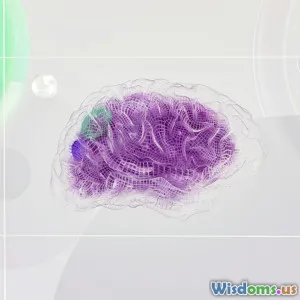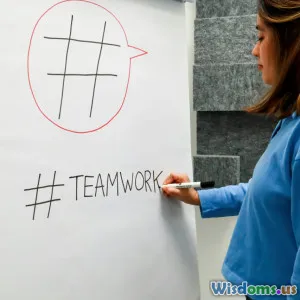
From Stuck To Unstoppable Overcoming Common Obstacles In Life
16 min read Discover practical strategies to transform life's obstacles into opportunities and move from stuck to unstoppable. (0 Reviews)
From Stuck To Unstoppable: Overcoming Common Obstacles In Life
Many of us find ourselves frozen at times, overwhelmed by life’s hurdles or burdened by setbacks that seem insurmountable. Whether it’s battling self-doubt, lingering regrets, or circumstantial barriers, the journey from stuck to unstoppable is within everyone’s grasp. Understanding the nature of these obstacles and equipping ourselves with actionable tools to overcome them can unlock a life of growth, purpose, and achievement.
Dissecting the "Stuck" Feeling: What Holds Us Back?

Before we can move forward, it’s important to recognize why we feel stuck in the first place. The sensation of being stuck often manifests as frustration, aimlessness, or feeling trapped by circumstance. Common triggers include career plateaus, personal losses, failed relationships, or even routine monotony.
Example: Consider the classic mid-career professional who dreads Monday mornings, yet doesn’t seek new opportunities due to fear of financial instability. Or the university graduate, brimming with potential, who hesitates to pursue their passion because of family expectations. In both cases, invisible yet powerful mental barriers impede progress.
Key Factors That Contribute:
- Fear of Failure: The anxiety of "what if it doesn’t work?" often paralyzes us before action can be taken.
- Limiting Beliefs: Thoughts like "I’m not good enough" or "I’ll never succeed" silently sabotage motivation.
- External Comparisons: Judging our progress against others leads to feelings of inadequacy.
- Lack of Clarity: Without a clear vision, it’s easy to drift rather than make deliberate moves forward.
Awareness is the first step towards transformation. By naming what’s holding us back, we’re already reducing its power over our actions.
Rewriting Your Internal Narrative

Many obstacles are fortified by the stories we tell ourselves. To break free, we must actively challenge and reframe these narratives.
Practical Steps To Change Your Story:
-
Start a Reflection Journal:
- Set aside ten minutes each evening to write about your daily experiences and feelings. This process can reveal patterns, persistent worries, or negative self-talk you may not consciously notice.
- Tip: Identify one limiting belief per week and examine its origins.
-
Reframe Negative Thoughts:
- Substitute "I never finish what I start" with "I’m capable of following through, as I proved when I completed X."
- Psychologists term this technique cognitive restructuring, widely used in Cognitive Behavioral Therapy (CBT) to combat self-sabotage.
-
Affirmations & Visualization:
- Repeatedly affirming constructive beliefs (e.g., "I am resilient under pressure") can reshape subconscious attitudes over time. Pairing affirmations with vivid visualizations increases their effectiveness, as found in numerous studies on sports performance psychology.
Case Insight: Simone Biles, one of the world’s leading gymnasts, regularly uses visualization before her performances to mitigate anxiety and boost confidence, turning perceived mental setbacks into fuel for greatness.
Breaking Down Big Obstacles: The Power Of Micro-Goals

A common reason people stall is feeling overwhelmed by the enormity of their challenges. The secret to momentum is breaking obstacles into bite-sized, achievable micro-goals.
How-To: Setting Actionable Micro-Goals
- Identify the Large Obstacle:
- Example: Applying for a new job after years in one position.
- Break it Down:
- Update your resume
- Research three companies per week
- Connect with two professionals on LinkedIn
- Schedule mock interviews
- Celebrate Small Wins:
- Treat each completed micro-goal as a milestone. This habit reinforces progress and maintains motivation.
Real-World Application: James Clear’s best-selling book Atomic Habits highlights how focusing on 1% improvements leads to staggering transformations. Jackie, a reader, lost 50 pounds by focusing solely on daily 10-minute walks, gradually building up confidence and capability.
Tools To Keep On Track:
- Kanban boards (physical or digital like Trello)
- Habit-tracking apps (e.g., Streaks, Habitica)
- Accountability buddies or mentors
Developing Mental Resilience: Bounce Back Stronger

Resilience is not a trait you’re born with, but a skill honed by adversity. Building mental toughness prepares you to persist through setbacks and bounce back when life doesn’t go as planned.
Strategies For Cultivating Resilience:
-
Practice Self-Compassion:
- Research published in Clinical Psychology Review shows that individuals who treat themselves kindly experience less depression and more motivation after failures.
- When you slip, replace harsh criticism with understanding: "Everyone struggles. What can I learn from this?"
-
Embrace Adaptability:
- The story of Netflix’s transformation from DVD rentals to streaming illustrates corporate and personal adaptability. When faced with the rise of digital media, they pivoted instead of clinging to a fading model, and achieved even greater success.
- Personally, remaining open to new methods, environments, or ideas fortifies you against uncertainty.
-
Setbacks As Data Points:
- Instead of viewing obstacles as evidence of incompetence, treat them as feedback. Edison famously remarked, "I have not failed. I’ve just found 10,000 ways that won’t work."
-
Mindfulness & Stress-Reduction:
- Evidence shows practices like meditation can fortify emotional regulation and buffer against stress-induced paralysis.
Proven Techniques To Overcome Specific Life Obstacles

No two hurdles are identical, but common obstacles often fall into several categories. Let’s explore tactical solutions for the most frequent challenges people encounter.
1. Fear Of Change
Tactic: Start with low-stakes experiments. If changing careers feels daunting, spend weekends shadowing professionals or volunteering in the new field. The NY Times highlighted numerous IT professionals who transitioned to environmental work by dedicating just 5% of their week to learn and connect with new networks.
2. Financial Hurdles
Tactic: Build a shock-absorber buffer. Setting aside as little as 2% of monthly income towards an emergency fund can gradually open doors otherwise restricted by money worries.
Example: During the COVID-19 pandemic, gig workers who had even minimal emergency savings weathered unemployment spells more calmly than those living entirely paycheck-to-paycheck, according to Pew Research.
3. Toxic Relationships
Tactic: Establish clear boundaries and practice assertive communication. Seek outside support when necessary. Studies confirm that individuals who maintain defined interpersonal boundaries experience less emotional exhaustion and greater life satisfaction.
4. Paralysis By Analysis
Tactic: Implement the "two-minute rule." If a decision or task takes less than two minutes to start, do it immediately. Popularized by David Allen's Getting Things Done methodology, this approach jumpstarts productivity and defeats inertia.
5. Lack Of Motivation
Tactic: Connect the obstacle to your deeper values and long-term vision. Motivation is sustained when tasks are clearly linked to meaningful goals. Simon Sinek's "Start With Why" framework helps individuals and organizations find their inspiring purpose.
Harnessing The Power Of Community And Support

One of the most underestimated resources in overcoming obstacles is community. Surrounding yourself with support vastly increases your odds of moving from stagnant to unstoppable.
Actionable Steps:
-
Seek Accountability:
- Research by the American Society of Training and Development found that people are 65% more likely to meet a goal after committing it to another person — and 95% more likely with ongoing check-ins.
- Join mastermind groups, find an accountability partner, or participate in online forums relevant to your goals.
-
Mentorship:
- A mentor accelerates learning curves and offers encouragement during rough patches.
- Example: Oprah Winfrey consistently credits her mentor, Maya Angelou, for invaluable guidance throughout her career evolution.
-
Celebrate Shared Successes:
- Recognize not only personal progress but community achievements, which sustains collective motivation.
Cultivating Lifelong Growth: The Role Of Curiosity And Learning

Those who continuously learn and adapt are most likely to leap over life’s hurdles and reinvent themselves. Intellectual curiosity keeps us open, resourceful, and humble.
How To Stay In "Growth Mode":
- Read Broadly: Expose yourself to varied viewpoints and disciplines.
- Pursue Low-Pressure Experiments: Take up a new hobby, attend diverse workshops, or try online courses (Coursera, Udemy, and edX offer thousands).
- Ask More Questions: When faced with a roadblock, ask, “What can I learn from this?” or “Who has overcome something similar before?”
- Adopt a "Begginer’s Mind": In Japanese philosophy, Shoshin describes the attitude of openness, eagerly taking in new knowledge regardless of level of expertise.
World Example: Satya Nadella credited adopting a learning mindset for transforming Microsoft’s culture from stagnant bureaucracy to leading-edge innovation, emphasizing empathy, and relentless curiosity.
The Art Of Perseverance: Sustaining Momentum When Progress Slows

Overcoming obstacles isn’t a "one-and-done" event; it’s often about sustaining action even when progress feels painstakingly slow.
Strategies To Persist:
-
Establish Non-Negotiable Habits:
- Habits like daily exercise, measured reflection, or unplugged time establish consistency, anchoring you during turbulent periods.
-
Track Progress Visually:
- Use progress jars, habit chains, or wall calendars to see physical proof of accomplishments—this creates a psychological effect called the "endowed progress effect," which enhances motivation.
-
Anticipate Plateaus:
- Recognize that progress comes in waves. Elite performers schedule rest and review periods, allowing the brain to consolidate gains. Deliberate pacing prevents burnout and ensures you’re equipped for the next surge forward.
-
Use Inspirational Benchmarks:
- Reflect on stories of people who’ve overcome adversity—think Malala Yousafzai advocating for education after an assassination attempt, or J.K. Rowling persevering through rejection before Harry Potter found a publisher. Their journeys show plateaus as stepping stones, not endpoints.
Turning Breakdowns Into Breakthroughs

Moments of breakdown often presage major breakthroughs. Resistance testifies to the presence of meaningful growth. The key is to lean in, glean insights, and transform adversity into advantage.
-
Document Your Journey:
- Journaling setbacks and lessons or capturing milestones creates a reservoir of wisdom to draw from during future challenges.
-
Share Your Story:
- Sharing your journey not only solidifies personal growth but serves as a beacon for others facing similar trials.
- Example: Actor Michael J. Fox’s openness about Parkinson’s disease has inspired millions and advanced scientific research.
-
Focus on Gratitude:
- Studies have shown that practicing gratitude measurably increases resilience, optimism, and overall well-being. Even while navigating setbacks, documenting what’s working shifts focus away from crisis to possibility.
Your Next Step: From Stagnant To Unstoppable
Obstacles are inevitable, but remaining stuck is optional. Every hurdle—personal, professional, or existential—can become a launching pad for growth if approached with the right strategies. Commit to honest self-inquiry, incremental action, resilient community, and an ever-curious spirit. With courage and strategy, you won’t just navigate life’s obstacles—you’ll become unstoppable, writing your own story of courage, perseverance, and triumph.
Rate the Post
User Reviews
Popular Posts



















